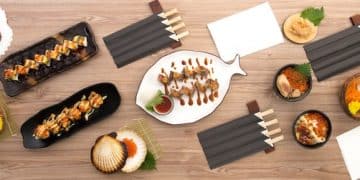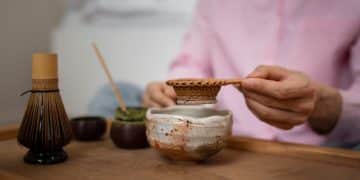Mastering Japanese Table Manners: A 2025 Guide for US Diners
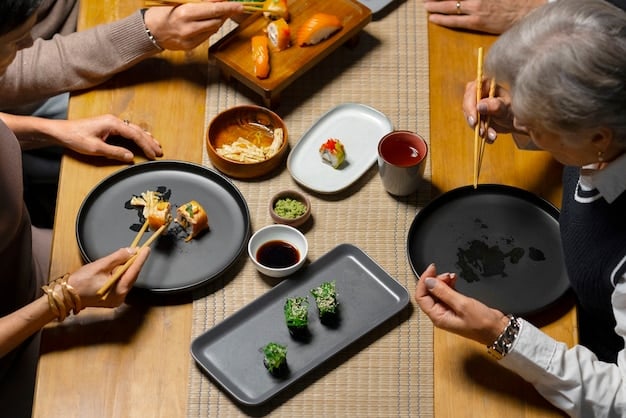
Decoding Japanese Table Manners: 10 Essential Rules for US Diners in 2025 involves understanding the nuances of chopstick etiquette, proper bowl handling, and the importance of showing respect for the food and the host, ensuring a smooth and culturally respectful dining experience.
Navigating Japanese cuisine is a delight, but mastering the etiquette can feel daunting. This guide, decoding Japanese table manners: 10 essential rules for US diners in 2025, ensures a graceful and respectful dining experience.
Understanding the Importance of Japanese Table Manners
Japanese table manners aren’t just about knowing which fork to use; they reflect deep-rooted cultural values. Understanding these customs shows respect and appreciation, paving the way for a more authentic and enjoyable experience.
Respect for Food
In Japan, food is treated with great reverence. Every step, from preparation to consumption, is imbued with respect. This translates into mindful eating and an appreciation for the ingredients.
Showing Gratitude
Before eating, it’s customary to say “itadakimasu,” which translates to “I humbly receive.” This acknowledges the life that was sacrificed for the meal and expresses gratitude to those who prepared it.
Key aspects include:
- Expressing gratitude with “itadakimasu” before eating and “gochisousama deshita” after the meal.
- Avoiding wasting food, showing appreciation for the resources and effort involved.
- Handling dishes with care and respect, avoiding unnecessary clanking or noise.
Understanding the importance of Japanese table manners goes beyond simply following rules; it’s about embracing a cultural value system that emphasizes respect, gratitude, and mindfulness in every aspect of dining.
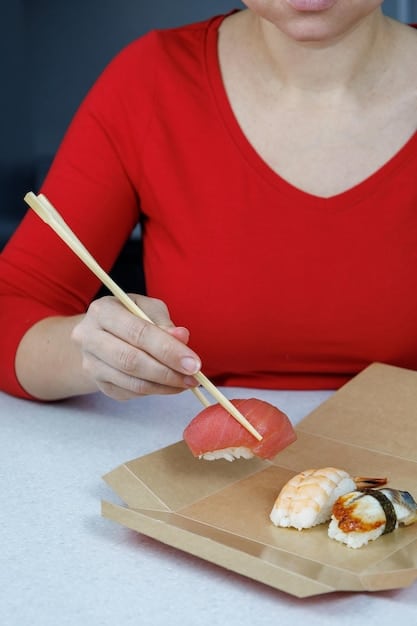
Mastering Chopstick Etiquette
Chopsticks are the primary eating utensil in Japan, and using them correctly is crucial. Proper chopstick etiquette shows respect and prevents unintentional offense.
Holding Chopsticks Correctly
The correct grip involves holding one chopstick like a pen and the other resting between the thumb and index finger. This allows for precise and controlled movements.
Prohibited Actions
Avoid sticking chopsticks upright in a bowl of rice, as this resembles a funeral ritual. Also, refrain from passing food directly from your chopsticks to someone else’s, as this is another funeral custom.
Here’s a breakdown of key chopstick rules:
- Never stick chopsticks vertically into rice.
- Avoid passing food directly from chopsticks to chopsticks.
- Don’t use chopsticks to move bowls or plates.
- Refrain from waving chopsticks in the air or using them to point.
Mastering chopstick etiquette is a fundamental aspect of Japanese table manners, demonstrating your respect for the culture and ensuring a smooth dining experience.
Navigating Bowl Handling
In Japanese dining, bowls are often picked up and held close to the mouth while eating. This allows for easier consumption and prevents spills.
Holding Rice and Soup Bowls
It’s acceptable to hold rice and soup bowls in one hand while eating, bringing them closer to your mouth. This makes it easier to use chopsticks effectively.
Using the Other Hand
The other hand can be used to support the bowl or to bring food to the mouth. Avoid placing elbows on the table while eating.
Key points for bowl handling include:
- Holding smaller bowls close to your mouth while eating.
- Using your free hand to support the bowl or guide food.
- Avoiding excessive noise or movement while handling bowls.
Proper bowl handling is an essential aspect of Japanese table manners, making the dining experience more comfortable and respectful.
Understanding Soup and Noodle Consumption
Soups and noodles are common dishes in Japan, and there are specific ways to enjoy them politely. Slurping, in particular, has a different connotation than in the US.
Slurping: Acceptable or Rude?
Slurping noodles is not only acceptable but also considered a sign of enjoyment. It enhances the flavor and cools down the noodles as you eat.
Drinking Soup Directly from the Bowl
It’s perfectly acceptable to drink soup directly from the bowl, especially miso soup. Feel free to lift the bowl to your mouth and sip the broth.
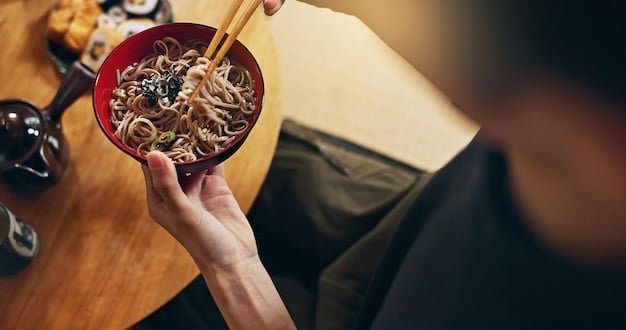
Here are some guidelines for soup and noodle consumption:
- Slurp noodles to show enjoyment and cool them down.
- Drink soup directly from the bowl.
- Use chopsticks to guide noodles into your mouth.
Understanding these nuances ensures you can enjoy soups and noodles authentically and respectfully.
The Art of Serving and Receiving
Serving and receiving food is an important aspect of Japanese hospitality. It’s a way to show consideration and respect for others at the table.
Pouring Drinks for Others
It’s customary to pour drinks for your companions, and they will reciprocate. Never pour your own drink; wait for someone to offer.
Using Two Hands
When receiving a drink, hold your glass with two hands to show respect and gratitude. This small gesture is highly appreciated.
Key etiquette points for serving and receiving include:
- Pouring drinks for others and allowing them to reciprocate.
- Holding your glass with two hands when receiving a drink.
- Offering food to others before serving yourself.
Practicing the art of serving and receiving demonstrates your respect for Japanese hospitality and enhances the communal dining experience.
Navigating Shared Dishes
Many Japanese meals involve shared dishes, and there are specific protocols for serving yourself from these platters.
Using Serving Utensils
Always use the serving utensils provided to take food from shared dishes. Avoid using your personal chopsticks, as this is considered unsanitary.
Taking Small Portions
Take small portions to ensure everyone has a chance to enjoy the dish. It’s better to go back for seconds than to take too much at once.
Guidelines for navigating shared dishes:
- Use serving utensils to take food from shared plates.
- Take small portions to ensure everyone has a chance to enjoy the dish.
- Avoid touching the food with your personal chopsticks.
Following these guidelines ensures that shared dishes are enjoyed hygienically and respectfully by everyone at the table.
Respecting the Host and Other Diners
Showing respect to the host and other diners is a fundamental aspect of Japanese table manners. It creates a harmonious and enjoyable dining atmosphere.
Arriving on Time
Punctuality is highly valued in Japan. Arriving on time shows respect for the host and the other guests.
Avoiding Loud Conversations
Refrain from engaging in loud or disruptive conversations. Maintain a respectful and considerate demeanor throughout the meal.
Respecting the host and other diners involves:
- Being punctual for the meal.
- Maintaining a quiet and respectful demeanor.
- Acknowledging and appreciating the host’s efforts.
By adhering to these courtesies, you contribute to a positive and respectful dining experience for everyone involved.
| Key Point | Brief Description |
|---|---|
| 🥢 Chopstick Etiquette | Avoid sticking chopsticks upright in rice or passing food directly between chopsticks. |
| 🍜 Slurping Noodles | Slurping noodles is acceptable and even encouraged as it enhances the flavor. |
| 🍚 Bowl Handling | It’s acceptable to lift rice and soup bowls close to your mouth while eating. |
| 🤝 Serving Others | Pour drinks for others and wait for someone to fill your glass. Receive drinks with two hands. |
Frequently Asked Questions
▼
Chopstick etiquette is crucial because it reflects deep-rooted cultural values and respect. Proper usage avoids actions associated with mourning rituals and ensures a harmonious dining experience by preventing unintentional social faux pas.
▼
Yes, slurping noodles is not only acceptable but often encouraged in Japan. It enhances the flavor by aerating the noodles and helps cool them down as they are eaten, signifying enjoyment of the meal.
▼
When serving yourself from shared dishes, always use the provided serving utensils to maintain hygiene. Avoid using your personal chopsticks. Take small portions initially to ensure everyone has an opportunity to enjoy the dish.
▼
“Itadakimasu” is said before starting a meal and translates to “I humbly receive.” It expresses gratitude for the life sacrificed to provide the meal and acknowledges the efforts of those who prepared it.
▼
Being on time is highly valued in Japan as a sign of respect. Arriving punctually demonstrates consideration for the host and other guests, reflecting an understanding of the importance of respecting others’ time.
Conclusion
By understanding and practicing these 10 essential rules of Japanese table manners, US diners can confidently navigate any dining situation in Japan in 2025. Embrace these customs to show respect, enhance your dining experience, and build meaningful cultural connections.
